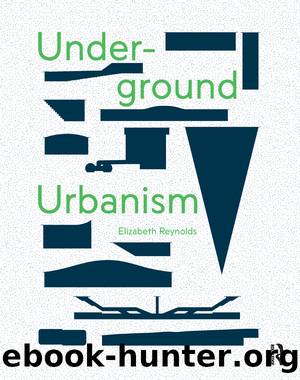Underground Urbanism by Reynolds Elizabeth;

Author:Reynolds, Elizabeth;
Language: eng
Format: epub
Publisher: Taylor & Francis Group
Published: 2020-06-15T00:00:00+00:00
Fig. 5.4
Cuyperpassage â entrance
Fig. 5.5
Cuyperpassage â mosaic
Fig. 5.6
Amsterdam Central Station â section with Cuyperpassage on lower level
Fig. 5.7 (over page)
Cuyperpassage, Amsterdam
32 Cleveland Street London, United Kingdom
In 2012 Make architects sought to find a new home for their London headquarters, not an easy task given their specific needs, however, by looking underground they were able to see the potential in an unlikely space. Wanting to stay in the Fitzrovia area of London close to good transport; clients; suppliers; other creative industries; and some fine pubs, Make began the search for somewhere to accommodate their growing team. The need to find a large office, all on one level, with street presence, and affordable rent in central London was an ambitious task. During their search, they became aware of a local car park that not only met their size and location requirements, but also offered the potential to showcase their ambition âto design the best buildings, places and spaces in the worldâ.
The 1,300 sqm car park is located in Middlesex House, a five-storey art deco building constructed in 1934 which in its early years accommodated factory space on the upper storeys and a car showroom in the basement. More recently the upper floors have been used as office space including by owners Derwent London, with the basement let to National Car Parks. Private vehicle use in central London has fallen in recent years and as a result, the car park was underutilised and attracting a lower property value per square foot than alternative spaces. When Derwent suggested the car park to Make they saw an opportunity to design their own unique studio, in a desirable area, with affordable rent and the security of long-term tenancy. In considering how to adapt the car park for use as an office, Make aimed to maintain the utilitarian, industrial look and feel of the space â with exposed services and pipework and retained original features such as the painted parking columns â yet also create a functional, high-spec studio space which could cater for approximately 160 employees. The office also had to adopt an open-plan layout, in line with Makeâs non-hierarchical company structure.
Download
This site does not store any files on its server. We only index and link to content provided by other sites. Please contact the content providers to delete copyright contents if any and email us, we'll remove relevant links or contents immediately.
| Automotive | Engineering |
| Transportation |
Whiskies Galore by Ian Buxton(40332)
Introduction to Aircraft Design (Cambridge Aerospace Series) by John P. Fielding(32338)
Small Unmanned Fixed-wing Aircraft Design by Andrew J. Keane Andras Sobester James P. Scanlan & András Sóbester & James P. Scanlan(32141)
Craft Beer for the Homebrewer by Michael Agnew(17447)
Turbulence by E. J. Noyes(7039)
The Complete Stick Figure Physics Tutorials by Allen Sarah(6638)
Kaplan MCAT General Chemistry Review by Kaplan(6054)
The Thirst by Nesbo Jo(5786)
Bad Blood by John Carreyrou(5769)
Learning SQL by Alan Beaulieu(5412)
Weapons of Math Destruction by Cathy O'Neil(5037)
Man-made Catastrophes and Risk Information Concealment by Dmitry Chernov & Didier Sornette(4736)
iGen by Jean M. Twenge(4702)
Digital Minimalism by Cal Newport;(4544)
Life 3.0: Being Human in the Age of Artificial Intelligence by Tegmark Max(4508)
Audition by Ryu Murakami(4099)
1,001 ASVAB Practice Questions For Dummies by Powers Rod(4039)
Electronic Devices & Circuits by Jacob Millman & Christos C. Halkias(4029)
Pale Blue Dot by Carl Sagan(4001)
